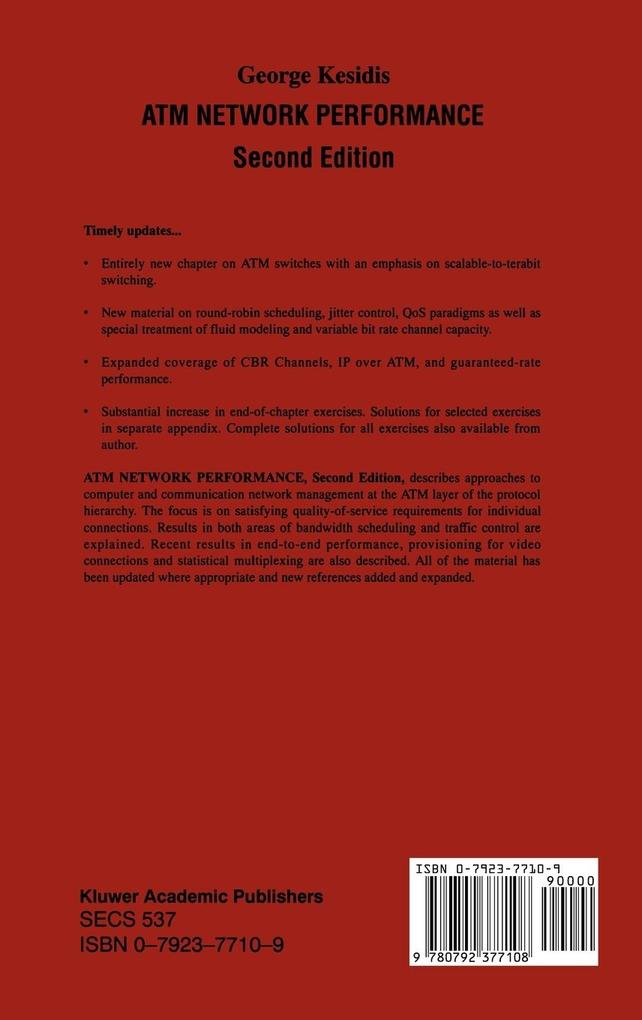
Zustellung: Di, 12.08. - Fr, 15.08.
Versand in 7 Tagen
VersandkostenfreiBestellen & in Filiale abholen:
ATM Network Performance, Second Edition, describes approaches to computer and communication network management at the ATM layer of the protocol hierarchy. The focus is on satisfying quality-of-service requirements for individual connections. Results in both areas of bandwidth scheduling and traffic control are explained. Recent results in end-to-end performance, provisioning for video connections and statistical multiplexing are also described. All of the material has been updated where appropriate and new references added and expanded.
Timely updates:
Timely updates:
- Entirely new chapter on ATM switches with an emphasis on scalable-to-terabit switching.
- New material on round-robin scheduling, jitter control, QoS paradigms as well as special treatment of fluid modeling and variable bit rate channel capacity.
- Expanded coverage of CBR channels, IP over ATM, and guaranteed-rate performance.
- Substantial increase in end-of-chapter exercises. Solutions for selected exercises in separate appendix. Complete solutions for all exercises also available from author.
Inhaltsverzeichnis
1 Introduction. - 1. 1 ATM Background. - 1. 2 A Queueing Model of an ATM Network. - 1. 3 The Evolving Internet. - 1. 4 Organization of the Book. - 1. 5 Discussion and Additional References. - 2 Discrete-Time Queues with Constant Service Rate. - 2. 1 Discrete-Time Lindley Processes. - 2. 2 (? , p) Constraints. - 2. 3 Obtaining (? , p) Constraints via Leaky Buckets. - 2. 4 Large Deviations Effective Bandwidths. - 2. 5 Extremal (? , p) and Peak-Rate Constrained Traffic. - 2. 6 Discussion and Additional References. - 2. 7 Exercises. - 3 Bandwidth Scheduling for a Single Node. - 3. 1 The Guaranteed-Rate Property. - 3. 2 Round-Robin Schedulers. - 3. 3 Schedulers Based on Virtual Finishing Times. - 3. 4 Fair Scheduling. - 3. 5 General Design Issues of Bandwidth Schedulers. - 3. 6 Discussion and Additional References. - 3. 7 Exercises. - 4 End-To-End Delay Bounds and Buffer Sizing. - 4. 1 End-to-End Delay Bounds. - 4. 2 Buffer Sizing for Lossless Transmission. - 4. 3 Buffer Sizing For Idling Schedulers. - 4. 4 Controlling Cell Delay Jitter. - 4. 5 Extensions to Arbitrary Virtual Path Connections. - 4. 6 Discussion and Additional References. - 4. 7 Exercises. - 5 The Flow Control Problem for ABR Traffic. - 5. 1 ABR Parameters. - 5. 2 Resource Management Cells. - 5. 3 RM Cell Delays. - 5. 4 Buffer Sizing. - 5. 5 Excess Bandwidth. - 5. 6 Distributing Excess Bandwidth Fairly. - 5. 7 Evaluating a Flow Control Policy. - 5. 8 Discussion and References. - 6 ATM Switches with the Guaranteed-Rate Property. - 6. 1 Single-Stage Switches. - 6. 2 General Design Issues for Single-Stage Switches. - 6. 3 Output-Buffered ATM Switches. - 6. 4 Input-Buffered ATM Switches. - 6. 5 Scalability. - 6. 6 Input/Output-Buffering. - 6. 7 Multicast Scheduling for Input-Buffered Switches. - 6. 8 Discussion and Additional References. - 6. 9 Exercises. - 7 Resource Provisioning for PrerecordedVideo. - 7. 1 Piecewise-CBR Service. - 7. 2 Quality-of-Service Requirements. - 7. 3 End-to-End Provisioning. - 7. 4 Discussion and Additional References. - 7. 5 Exercises. - 8 Real-Time VBR Video Teleconferencing. - 8. 1 A VPC for a Real-Time Video Bundle. - 8. 2 QoS Requirements of the Video Flow. - 8. 3 Bandwidth Requirements at Each Hop. - 8. 4 Admission Control Summary. - 8. 5 On-Line Traffic Measurements. - 8. 6 Discussion and Additional References. - 8. 7 Exercises. - References. - A Glossary of Acronyms and Short Forms. - B Solutions and References for Selected Exercises.
Produktdetails
Erscheinungsdatum
31. Dezember 1999
Sprache
englisch
Untertitel
Second Edition 2000.
XIV, 206 p.
Sprache: Englisch.
Auflage
Second Edition 2000
Seitenanzahl
228
Reihe
The Springer International Series in Engineering and Computer Science
Autor/Autorin
George Kesidis
Illustrationen
XIV, 206 p.
Verlag/Hersteller
Produktart
gebunden
Abbildungen
XIV, 206 p.
Gewicht
512 g
Größe (L/B/H)
241/160/17 mm
ISBN
9780792377108
Entdecken Sie mehr
Bewertungen
0 Bewertungen
Es wurden noch keine Bewertungen abgegeben. Schreiben Sie die erste Bewertung zu "ATM Network Performance" und helfen Sie damit anderen bei der Kaufentscheidung.











